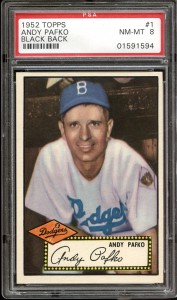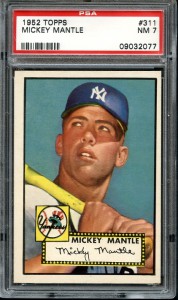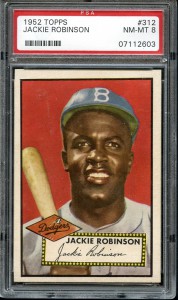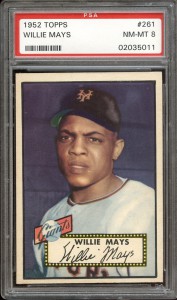From the very start of baseball images printed on cardboard in the mid 19th Century to today, collectors have chosen their favorites for various reasons. But if you were to survey the millions of enthusiasts across this great nation, you’d likely find that one set stands at the zenith of the baseball card collecting universe: the 1952 Topps collection.
With all due respect to the legendary 1909-1911 T206 and 1933 Goudey collections, each of which could also take years, or decades, or even a lifetime to complete, the ’52 Topps set holds a singular distinction to advanced collectors, many of which have lived long enough to see the diamond heroes contained within. While 1909-1933 saw the transition of baseball card distribution go from tobacco to bubble gum, it wasn’t until 1952 that the baseball card market became a driving force in American culture.
The Beginning of a Renaissance
Offering cards to sell bubble gum was not a new idea for Topps. In 1950, Topps attempted to increase sales by marketing their product in tandem with Hopalong Cassidy trading cards. Less than two years later, on a typical autumn eve in 1951, 28-year old World War II veteran Sy Berger sat down with Woody Gelman at the kitchen table of his Brooklyn apartment and devised a plan to challenge the Bowman Gum Company, the lone giant in the baseball card market since 1948, by designing what would become the standard-bearer for an entire industry. Rejecting the traditions and conventional wisdom set forth by Bowman, Berger’s 1952 Topps set would provide a dramatic alternative. By offering super-sized 2-5/8″ by 3-3/4″ pasteboards which included the player’s name, colorized photo, facsimile autograph, and color team logo on the front with the player’s height, weight, batting and throwing orientation, birthplace, birthday, career stats, and a short biography on the back, Berger and Gelman introduced innovations to the generations-old concept of baseball trading cards that are still employed today.
The New Kid on the Diamond

Entering a new phase of the company’s evolution, Topps’ marketing strategy was to emphasize that their product offered greater size compared to the competition, packaging and selling the cards in a bright green and red wrapper as “five giant size picture cards” with a stick of bubble gum. Sprawling displays that touted the new Topps trading cards infiltrated nearly every Woolworths and “five & dime shop” in the nation, with seemingly endless stacks of wax packs, boxes, and even cases available for purchase. With Brooklyn Dodger Andy Pafko as the premier card of the inaugural set, the 80-card first series wasn’t without its growing pains. Existing in both black-back and red-back variations, it’s apparent that the red-back cards consistently offer superior picture quality, leading to speculation that Topps was not happy with their first attempt and resolved to make improvements by increasing the quality while changing the reverse color to red as a sort of “clean slate” approach. The Johnny Sain and Joe Page “wrong back” errors (#48 and #49) exist only in black-back form as they were corrected before the switch to red; only the correct version exists on the red-back variety. All cards after the first series are in red-back form only. High grade specimens of the black-back cards are almost always scarcer then their corresponding red-backs, suggesting that the switch from black to red happened fairly early in the process and considerably fewer black-backs made it into circulation.
High-numbers: The Set Builder’s “White Whale”
 Initial sales were encouraging enough for Topps to begin planning a 1953 edition and the company felt confident that withholding baseball icons Mickey Mantle, Jackie Robinson, Roy Campanella and Eddie Mathews until the final series would offset any drop in demand due to the upcoming football season. But that series (#311-407) was delayed and barely made it out of production by September. To make matters worse, many stores that successfully sold the product all season chose not to order the final series so late in the year and collectors were either unable to locate the cards or were simply unaware that the cards even existed. Not even an appearance by the “Commerce Comet” could turn the tide and sales plummeted. With cases of unsold product stranded in the Topps warehouse for years, Sy Berger decided in 1960 to load up a tugboat with approximately 300 to 500 cases of 1952 final series product and dispose of it New York Harbor, sending them to a watery grave somewhere off the coast of northern New Jersey. For this obvious reason, the famous Mickey Mantle card #311 and all other final series issues are unusually scarce, especially in presentable condition.
Initial sales were encouraging enough for Topps to begin planning a 1953 edition and the company felt confident that withholding baseball icons Mickey Mantle, Jackie Robinson, Roy Campanella and Eddie Mathews until the final series would offset any drop in demand due to the upcoming football season. But that series (#311-407) was delayed and barely made it out of production by September. To make matters worse, many stores that successfully sold the product all season chose not to order the final series so late in the year and collectors were either unable to locate the cards or were simply unaware that the cards even existed. Not even an appearance by the “Commerce Comet” could turn the tide and sales plummeted. With cases of unsold product stranded in the Topps warehouse for years, Sy Berger decided in 1960 to load up a tugboat with approximately 300 to 500 cases of 1952 final series product and dispose of it New York Harbor, sending them to a watery grave somewhere off the coast of northern New Jersey. For this obvious reason, the famous Mickey Mantle card #311 and all other final series issues are unusually scarce, especially in presentable condition.
1952 Topps Master Set #3 Current Finest on PSA Set Registry – The Finest Master Set Ever Offered
 As a Master Set, ranked #3 on the PSA Set Registry, the collection includes all 407 cards in the series with the 80 additional 1st series cards in “black-back” form, the celebrated Joe Page and Johnny Sain “wrong bio” reverses (#48 and 49) and the newly discovered and scarce Frank Campos “black star” variation (#307 graded PSA 5), bringing the total collection to 490 cards. The cornerstones of the set are naturally the Mickey Mantle card #311, a fresh and vibrant PSA 7 with an above-grade perimeter and incredible image quality to offset the typical centering variance, a phenomenal PSA 7.5 specimen of Eddie Mathews’ rookie card #407 and a breathtaking PSA 8 black-back version of Andy Pafko’s card #1, one of just 5 in existence with a lone specimen graded higher, along with a PSA 6 of the red back variety. Nine cards are graded PSA 9, headlined by card #2 James Runnels black-back (one of 2 with just one graded higher) and including #38 Westlake (pop 4, none higher), 71 Upton (pop 2, none higher), 108 Konstanty (pop 5, none higher), 207 Harris (pop 10, none higher), 210 Fowler (pop 7, none higher), 245 Robertson (pop 5, none higher), 292 Baker (pop 8, none higher), and 322 Jackson (pop 7, none higher).
As a Master Set, ranked #3 on the PSA Set Registry, the collection includes all 407 cards in the series with the 80 additional 1st series cards in “black-back” form, the celebrated Joe Page and Johnny Sain “wrong bio” reverses (#48 and 49) and the newly discovered and scarce Frank Campos “black star” variation (#307 graded PSA 5), bringing the total collection to 490 cards. The cornerstones of the set are naturally the Mickey Mantle card #311, a fresh and vibrant PSA 7 with an above-grade perimeter and incredible image quality to offset the typical centering variance, a phenomenal PSA 7.5 specimen of Eddie Mathews’ rookie card #407 and a breathtaking PSA 8 black-back version of Andy Pafko’s card #1, one of just 5 in existence with a lone specimen graded higher, along with a PSA 6 of the red back variety. Nine cards are graded PSA 9, headlined by card #2 James Runnels black-back (one of 2 with just one graded higher) and including #38 Westlake (pop 4, none higher), 71 Upton (pop 2, none higher), 108 Konstanty (pop 5, none higher), 207 Harris (pop 10, none higher), 210 Fowler (pop 7, none higher), 245 Robertson (pop 5, none higher), 292 Baker (pop 8, none higher), and 322 Jackson (pop 7, none higher).  Other extremely high-grade low pops include PSA 8.5 cards of #12 Basgall (pop 1, two higher), 131 Martin (pop 3 none higher), 246 Kell (pop 3, two higher) and 398 Rice (Pop 1, one higher) with incredibly sought-after PSA 8 rarities of #9 Hogue red-back, 11 Rizzuto black-back, 20 Loes red-back, 48 Page correct bio black-back, 49 Sain correct bio red-back, 162 Crandall, 165 Kazak, 175 B. Martin, 180 Maxwell, 261 Mays, 312 J. Robinson, 316 Williams, 320 Rutherford, 326 Shuba, 341 Jeffcoat, 373 Turner, 388 Chipman, and 403 Miller. Over 83% of the entire collection (9 PSA 9, 15 PSA 8.5, and 384 PSA 8) is graded PSA 8 or above. A link to the complete card by card breakdown of this set, including individual grades and populations, will be available through our website or by visiting the PSA Set Registry. This collection is being offered as a complete set as well as each card offered individually, with the final sale going to whichever total (the set versus the sum of the individual lots) is higher. This gives prospective bidders the opportunity to examine each and every card in the collection through the use of our high quality scans. We’ve been honored to offer some of the world’s finest 1952 Topps sets over the past few years, but this collection takes it to a whole new level of excellence!
Other extremely high-grade low pops include PSA 8.5 cards of #12 Basgall (pop 1, two higher), 131 Martin (pop 3 none higher), 246 Kell (pop 3, two higher) and 398 Rice (Pop 1, one higher) with incredibly sought-after PSA 8 rarities of #9 Hogue red-back, 11 Rizzuto black-back, 20 Loes red-back, 48 Page correct bio black-back, 49 Sain correct bio red-back, 162 Crandall, 165 Kazak, 175 B. Martin, 180 Maxwell, 261 Mays, 312 J. Robinson, 316 Williams, 320 Rutherford, 326 Shuba, 341 Jeffcoat, 373 Turner, 388 Chipman, and 403 Miller. Over 83% of the entire collection (9 PSA 9, 15 PSA 8.5, and 384 PSA 8) is graded PSA 8 or above. A link to the complete card by card breakdown of this set, including individual grades and populations, will be available through our website or by visiting the PSA Set Registry. This collection is being offered as a complete set as well as each card offered individually, with the final sale going to whichever total (the set versus the sum of the individual lots) is higher. This gives prospective bidders the opportunity to examine each and every card in the collection through the use of our high quality scans. We’ve been honored to offer some of the world’s finest 1952 Topps sets over the past few years, but this collection takes it to a whole new level of excellence!
